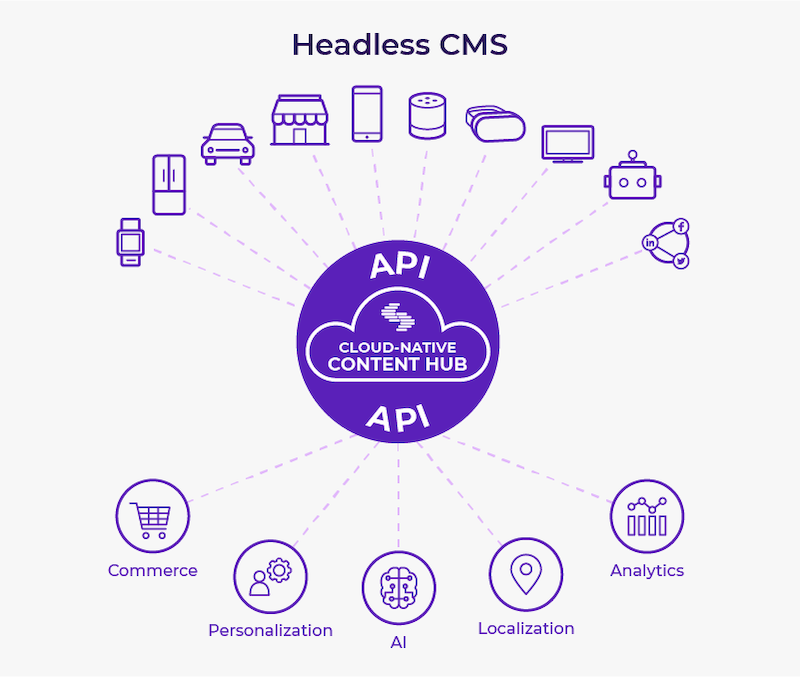Headless CMS SEO: Your path to superior online rankings

Discover the power of headless CMS SEO for unmatched speed, flexibility and performance. Enhance your content delivery and boost your search rankings with cutting-edge strategies. Don't miss out on transforming your digital presence — explore the benefits of headless CMS SEO.
Highlights
You’ll learn about why headless SEO is important:
- Improve speed: Headless CMS separates front-end and back-end, enhancing load times
- Make your system flexible: Allows integration with modern technologies, adapting to changing needs
- Ensures better performance: Optimizes technical SEO aspects like mobile responsiveness and URL structure
A headless CMS SEO helps you with digital transformation. Transform your strategy for superior search rankings and a seamless user experience.
Have you heard the silent whispers surrounding a headless content management system (CMS)? The latest trend promises superior flexibility, scalability and agility. Imagine managing content from one place and delivering a consistent experience across every digital platform.
Sounds super easy, right?
But if you’re here, you’re probably confused about whether to adopt a headless approach. Search engine optimization is a ranking factor and you don’t want to lose top search engine spots on Google by migrating to a new CMS.
Contrary to popular belief, a headless CMS is good for SEO efforts. Headless CMS like Contentstack improves your search engine rankings. With organic traffic generating more than half of all trackable web traffic, a headless CMS is excellent for your tech stack and adds to your SEO efforts.
So, how does headless CMS improve your SEO efforts and bring a much-desired change to your marketing strategy?
What is headless SEO?
Headless SEO optimizes your headless CMS website to improve its search results performance. A headless CMS SEO employs various strategies to ensure that search engines like Google can efficiently crawl, index and rank your content. In a headless SEO, you implement elements like structured data, fine-tune content aspects and incorporate front-end frameworks to deliver pleasant user experience and adhere to SEO principles.
Unlike traditional SEO methods, headless SEO offers a more flexible approach. It allows marketers to adapt to changing algorithms and user habits, leading to better search rankings and a higher reach across various platforms.
Since a headless CMS centrally matches your content across different platforms, headless SEO optimizes your content regardless of where and how you serve it.
Overcome traditional CMS issues with Contentstack: Are you tired of slow development times and rising costs due to legacy monolithic suites? Contentstack offers a modern, component-based solution designed for the needs of today's enterprises. Discover agility and improved ROI. Request a demo to learn more.
Myths of a headless SEO
With the increased adoption of headless SEO, several myths have emerged. The first myth is that headless systems make a website more SEO-friendly because they are not tied to traditional CMS. In other words, although headless architecture provides better flexibility and improved performance, it cannot enhance SEO.
Another misconception is that traditional SEO practices are no longer needed once a website adopts a headless approach. In truth, basics like keyword research, good content and backlinks are still crucial, no matter what CMS architecture you use. Some also think a headless CMS means you can skip ongoing SEO monitoring and changes. However, regular analysis and updates help you keep up with algorithm changes and shifting user needs.
As these are myths, a headless CMS is a boon for your organic traffic and search engine ranking.
Benefits of headless CMS for SEO
Improves website speed
Headless CMS solutions speed up your website by separating the front-end and back-end processes. Imagine fetching content directly from the server and displaying it with lightweight front-end tools. Faster load times mean smoother digital experiences and search engine friendliness, which ranks your website higher on search engine result pages (SERPs).

Better content delivery
A headless architecture allows content to flow across various platforms and devices, such as phones, tablets and smart gadgets. Your users enjoy a consistent, high-quality experience regardless of their device, leading to lower bounce rates and higher engagement—key for strong SEO performance and digital success.
Enhances user experience
A headless CMS supports modern front-end technologies like React, Angular and Vue.js, focusing on user experience. These tools let developers create dynamic, interactive layouts that ensure faster interactions and personalized content. Happy users lead to better search engine rankings, making your website more valuable and engaging.
Scales with your needs
As your content demands and audience expand, a headless CMS grows without sacrificing your website’s performance. Scalable solutions help you expand your digital footprint without the limits of traditional CMS platforms. The system integrates with new technologies and systems, ensuring long-term success.
Ensures flexibility
The decoupled nature of a headless CMS allows businesses to try out different front-end frameworks and technologies without messing with the CMS. This flexibility allows your team to apply the latest SEO practices and tailor the user interface to keep up with changing business and audience needs, ensuring your content strategies are fresh and compelling.
Facilitates content production
A headless architecture streamlines content creation and distribution by integrating content APIs and automation tools. As a result, you maintain a fresh, relevant and updated online presence, which search engines reward with higher visibility. When your workflow becomes simple and you automate processes, you can manage large volumes of content and deliver it to the right audience at the right time, ensuring ongoing engagement and interest.
Improves technical SEO
Unlike traditional CMS like WordPress, a headless system fine-tunes the technical aspect of your website to make it more SEO-friendly. Here are the technical aspects which a headless CMS improves:
- Optimize page speed
- Ensure mobile responsiveness for a great user experience
- Create a clean and optimized URL structure for higher searchability
- Avoid content redirects to ensure your users don’t hit the broken links
- Use structured data markup to provide search engines with richer information
Best practices for headless CMS SEO
Ensure content editors can modify the URL
An essential best practice for headless CMS SEO is ensuring your content editors can modify your URLs. URLs are crucial for SEO since they affect how search engines read and rank your content. That's why it's essential to have a user-friendly interface where editors can effortlessly edit slugs, include keywords and keep things organized.
Create rules for canonical URLs
Setting up canonical URLs helps avoid duplicate content issues when the same material is available via different URLs. This confuses search engines and weakens a webpage's ranking. You can establish clear guidelines for using canonical tags in a headless CMS. Search engines can quickly identify the preferred version of a page, consolidating all link equity. This approach keeps the user experience consistent and boosts a site's ranking potential by channeling all ranking signals to one authoritative page version.
Know your XML sitemap setup
While everyone knows this, XML sitemaps are dynamic files that must be updated at specific intervals. Talk with your development team to determine how you plan to update your sitemap when it contains canonical URLs with a 200 HTTP response code to improve your SEO efforts. The process involves creating a dynamic sitemap that automatically updates with new pages and removes outdated or irrelevant content. By setting appropriate priority and frequency in the sitemap, search engines focus on your most important pages, improving indexation and visibility.
An organized XML sitemap increases your website's discoverability and promotes interaction between your content and search engines.
Request a field for schema markup
Adding schema markup increases your content's visibility in search results. This structured data helps search engines understand your content, leading to standout placements like rich snippets. Schema markup gives your users more context about your content and helps you stay competitive.
Ensure mobile optimization
As more people use mobile devices to access the internet, you need to focus on optimizing for mobile. Ensure your headless CMS supports responsive design so your site or app looks great and works well on all screen sizes, whether a smartphone or a tablet. This increases your user experience as your visitors can interact with your content.
Optimize titles, meta tags and metadata
Creating catchy titles and meta descriptions increases the number of clicks from search engine results. These elements are like your content's first impression on potential visitors and often influence whether they visit your website. A good title hooks users with a promise or an intriguing question, while a strong meta description summarizes what they will find. Tweaking and improving your titles, meta tags and metadata improves your content's visibility and attractiveness, bringing more traffic to your website.
Create user-focused content
Relevance and quality are essential to effective SEO. Focus on creating content that speaks to your audience by tapping into their needs and interests. Integrating user engagement insights with your SEO tactics improves organic traffic and website visibility.
Focus on performance optimization
A fast website improves your user experience and SEO. Slow pages lead to higher bounce rates and poor search rankings. Regularly check and adjust your headless CMS configuration to keep your site performing well and reduce load times. Look out for bottlenecks or inefficiencies that are slowing your website. Also, consider using content delivery networks (CDNs) and caching strategies. These help you distribute your content across multiple servers, reducing the time users need to access your website. Doing this ensures a smoother experience for visitors and increases your website's visibility.
How is headless SEO different?
Understanding different rendering techniques optimizes your content delivery and improves search engine visibility. Here are the main rendering methods and their SEO implications:
Dynamic rendering
Dynamic rendering serves different content to search engine bots than to regular users. This method ensures search engines access fully rendered content, enhancing indexation. A website can provide bots a pre-rendered version of pages while users get a client-side rendered or interactive version. This is useful for complex JavaScript-heavy applications, but careful implementation maintains consistency between user and bot experiences.
Client-side rendering
In client-side rendering (CSR), the browser pulls HTML documents and the required data with JavaScript's help. This may lead to a longer time for the first page to load, as content loads only after loading JavaScript. A downside of employing CSR is that your search engines cannot execute JavaScript, which leaves content half-indexed. To overcome this, one has to either enable server-side rendering or use prerendering tools to make their content accessible for crawling.
Server-side rendering
Server-side rendering (SSR) presents a rendered HTML page to users and search engines, optimizing your website by delivering a complete version of the content upon the first request. SSR solves many indexing challenges seen with CSR and improves load times for first-time visitors. SSR with a headless CMS provides a dynamic user experience while maintaining strong SEO.
Hybrid rendering
Hybrid rendering combines CSR and SSR's advantages, offering flexibility in content delivery. You can pre-render certain pages for SEO, which involves optimizing a webpage to fulfill the needs of your users and search engines. You improve user engagement and search engine ranking whenever you decide on the rendering strategy for various website sections.
How does Contentstack help with SEO?
Contentstack adopts a headless approach that enhances your SEO. Its API-first design provides immediate and efficient content sharing to various platforms. As a result, your users can load your pages faster, improving your website's position in search engine results.
The platform offers various SEO tools, such as customizable URLs, metadata management and schema markup integration. With an intuitive interface, your content creators and editors create engaging titles and meta descriptions.
Contentstack supports dynamic and personalized content delivery, creating meaningful experiences that resonate with your audience. When you analyze engagement metrics and user behavior, you refine your SEO strategies, increase your click-through rates and decrease bounce rates.
Moreover, Contentstack updates users with automatic XML sitemap updates, ensuring search engines recognize new content. Contentstack emphasizes on mobile optimization and performance to provide an SEO solution.
IDC MarketScape recognizes Contentstack's excellence, naming us a Leader in Headless CMS by IDC MarketScape, Contentstack demonstrates a future-proof CMS strategy, R&D pace in innovation, and exceptional customer delivery. Discover how we can elevate your digital experiences. Request a demo to learn more.
Case study: How did Contentstack improve Assembly’s website performance?
Assembly modernized its web presence using three siloed WordPress websites into a single website using Contentstack's headless CMS. This change enhanced content management with reusable templates, streamlined publishing and reduced developer’s reliance. The new platform, which has an AI assistant, improved the efficiency of SEO tasks and enabled robust A/B testing and analytics. Key benefits include a 50% reduction in publishing time, improved website performance and a future-proof marketing tech stack.
After using Contentstack, Jessica Collier, VP of Growth Marketing at Assembly, said:
“Rebranding, consolidating three sites and launching a new domain alongside a new content management system was a big undertaking for us! But it has also been a transformative journey. I don't think I truly understood the biggest benefit of headless technology at first, but now I'm seeing the value. It’s future-proof. There’s always going to be something changing, whether it’s in Google’s algorithms, or with new technology to adopt. Contentstack’s underlying platform allows us to be really agile, to scale — to try new things and to eliminate constraints.”
Read the case study here.
FAQs
Is headless CMS better for SEO?
Yes, a headless CMS provides superior flexibility, performance and scalability, contributing to your SEO efforts.
What is a headless CMS example?
Contentstack is a leading headless CMS that provides SEO features that improve content management and search engine rankings.
What is CMS in SEO?
CMS in SEO refers to systems and practices that optimize content managed by a CMS for search engines.
What are 3 benefits of using a headless CMS?
- Enhanced speed and performance
- Flexibility in content delivery across platforms
- Improved SEO capabilities through modern web technologies
Learn more
So, is your headless CMS bad for your SEO?
Definitely not!
A headless CMS like Contentstack is excellent for your SEO efforts because it reduces page load time, makes your website scalable and improves website performance. The need to request a specific technical set-up creates some friction, but in the long-run it makes your website beat your competitors in terms of organic ranking. The possibilities offered by a headless SEO are endless.
To know how Contentstack helps you with your SEO effort, talk to us.
About Contentstack
The Contentstack team comprises highly skilled professionals specializing in product marketing, customer acquisition and retention, and digital marketing strategy. With extensive experience holding senior positions at renowned technology companies across Fortune 500, mid-size, and start-up sectors, our team offers impactful solutions based on diverse backgrounds and extensive industry knowledge.
Contentstack is on a mission to deliver the world’s best digital experiences through a fusion of cutting-edge content management, customer data, personalization, and AI technology. Iconic brands, such as AirFrance KLM, ASICS, Burberry, Mattel, Mitsubishi, and Walmart, depend on the platform to rise above the noise in today's crowded digital markets and gain their competitive edge.
In January 2025, Contentstack proudly secured its first-ever position as a Visionary in the 2025 Gartner® Magic Quadrant™ for Digital Experience Platforms (DXP). Further solidifying its prominent standing, Contentstack was recognized as a Leader in the Forrester Research, Inc. March 2025 report, “The Forrester Wave™: Content Management Systems (CMS), Q1 2025.” Contentstack was the only pure headless provider named as a Leader in the report, which evaluated 13 top CMS providers on 19 criteria for current offering and strategy.
Follow Contentstack on LinkedIn.




.svg?format=pjpg&auto=webp)
.svg?format=pjpg&auto=webp)
.png?format=pjpg&auto=webp)






.png?format=pjpg&auto=webp)

